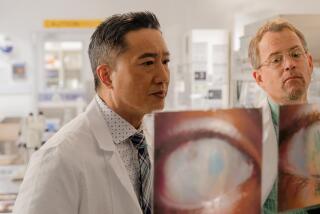Implant Liberates the Deaf From Silence
“Me have nothing. Me deafy. Speech inept. Intelligence--tiny blockhead. English--blow away. Left one you. Depend--no. Think myself enough. . . .”
Sarah Norman’s poignant opening lines from the play “Children of a Lesser God” gain clarity through translation.
Translation: I have nothing; no hearing, no speech, no intelligence, no language. I have only you. I don’t need you. I have me alone . . . .
Sarah speaks with her hands in the language of another world: the deaf world.
“Think myself enough,” she says.
A great many deaf people retreat from the outside world, and think themselves enough. They see little choice in the matter.
Life in a Bottle
To live without sound is to live in a bottle, said Dr. William F. House. “You can see out of the bottle, but you can’t be a part of the world outside.”
House smashed the bottle by inventing a device that for the first time gives hearing to the profoundly deaf. While the sound transmitted by the 3M House Cochlear Implant System is imperfect--users describe it as fuzzy--it transports the deaf to a hearing universe. It liberates them from an often debilitating, isolated world of utter silence.
House, who is president of the House Ear Institute in Los Angeles, took 27 years to develop the cochlear implant. In November, the Food and Drug Administration finally approved it for adult use. The institute has trained 52 physicians in the United States and abroad to perform the implant operation, and some of those doctors have trained 20 more to implant the devices.
Implanting the device in people under 18 still is limited to eight medical centers in the United States. The only one in California is the House Ear Institute.
Basically, the implant works by electronically stimulating the auditory nerve. A tiny microphone picks up sound and transmits it to a signal processor about the size of half a pack of playing cards where the signal is modified and amplified. The signal then runs through a wire to a coil above the ear from which it travels through the skin to a similar coil beneath the skin of the head. The two coils are held together magnetically through the skin. A wire leads from the interior coil through the skull to the cochlea (inner ear). The electronic signal to the cochlea stimulates the auditory nerve, producing a hearing effect.
About 665 people, including 164 children, have tried the 3M House implant, which is named for its inventor and its manufacturer. The device is not universally popular. About 30% of the adults born deaf who tried implants quit using them after a short time.
People born deaf feel safer in their own environment, House said. They have never known the hearing environment. To many born deaf, the hearing world is threatening and alien. It ignores the deaf and often is annoyed by them.
There is a defensive sense of alienation and, sometimes, superiority among some born deaf. “They have their lives, their culture, which is not understood by the hearing,” House said.
Although born deaf sometimes reject the implant, it is extraordinarily popular with others, despite problems including its uselessness in hearing telephone conversations and occasional breakdowns that require surgery for repair.
The implant has an impressive success rate among all children and among adults who lost their hearing after having learned to speak. About 90% of adults who learn to speak, then go deaf and then try the implant, stick with it. The figure rises to 97% for children 18 and under, and the 3% who have stopped using the device have all been teen-agers.
Janet Doak, vice president of the House Ear Institute, attributes the high success rate among young children to the fact that, even though they may have been born deaf, they haven’t had time to develop their own world sufficiently to let it separate them entirely from the hearing world. As for adults who have experienced hearing and lost it, they want the treasure back, Doak said.
What It Costs
It is not cheap to regain hearing. With the recent FDA approval, most insurance companies will pay 80% of the $4,000 to $5,000 cost of an implant plus the same percentage of the $6,000 to $7,000 needed for doctor, hospital and rehabilitation fees. Alternatives are expensive, too. It costs more than $22,800 a year to keep a student at the California School for the Deaf, Riverside, an official of the state-run institution said.
Among its users there is no doubt about the value of a 3M House cochlear implant. X-ray technician Darlene Fragale had an implant in 1979 and thought it was good enough to undergo a second operation for a second implant three years later when the technology of the device had improved significantly.
‘An Absolute Miracle’
“It puts me in touch with my environment. I don’t butt into conversations any more. I hear traffic. I hear telephones. It broke me free from an isolated cocoon,” said the 51-year-old Montrose resident who suffers from disease that causes softening of the bones of the inner ear.
“When you compare hearing with the implant and without it, the implant is an absolute miracle,” said Nancy Brown, wife of Judge Richard Brown of Oshkosh, Wis., presiding judge of Wisconsin’s appellate district 2, which covers about a quarter of the state.
“Without the implant he’s totally deaf,” Brown said of her 38-year-old husband who lost hearing in his right ear as a child with measles and in his left ear when a tumor was removed from it two years ago. “With the implant he can identify you by voice, but he can’t understand every word. When he is looking at you, he can combine lip reading and hearing and a lot of people think he has normal hearing. He’s told me that his hearing with the implant is like a radio that is not right on the station.” The judge is a marathon runner, and a better dancer than when he had normal hearing, his wife said. He can’t hear music as such when there is more than one instrument playing, but he can always pick up the beat.
Although she doesn’t really understand it yet, a 3M House implant has been as valuable to Kristen Corey as it has to Judge Brown. When Kristen was 22 months old she caught spinal meningitis. It deafened her. “She would have been lucky to hear a jet airplane at Los Angeles International Airport,” said her mother Debbie, a Claremont insurance agent.
Today, at 4 1/2, Kristen is a joyful youngster in a preschool with hearing children. She has a 3M House implant.
Kristen slurs her words and is not always easily understood. Her vocabulary is relatively small because it was arrested when she went deaf. But watching her play from a distance, she appears to be a normal, gregarious child.
“She’s able to function as well as the other kids as far as the activities go,” said Rita Novak, Kristen’s teacher at Indian Hill Day Care in Claremont. “Most of the children in her age group know her and are aware of her situation and get along with her.”
Sometimes other children yell at Kristen in an effort to help her understand, the same way people talk loudly to foreigners in a ridiculously futile effort to make them understand a language they don’t know. “That’s when I step in and explain to them that they don’t need to yell louder, they need to show her what’s needed,” Novak said. “She’s treated a little bit specially, but not as any type of handicapped person, and I think that helps her to adjust well.”
Kristen is adjusting well to a world that her young peers take for granted. For her it is a world that wouldn’t exist without the 3M House Cochlear Implant System.
More to Read
Sign up for Essential California
The most important California stories and recommendations in your inbox every morning.
You may occasionally receive promotional content from the Los Angeles Times.










